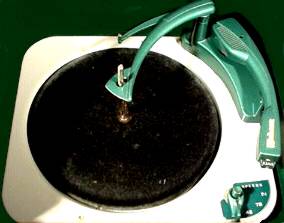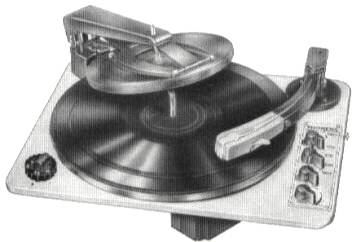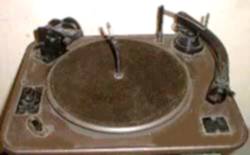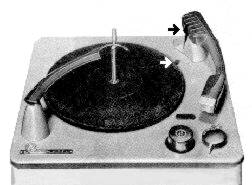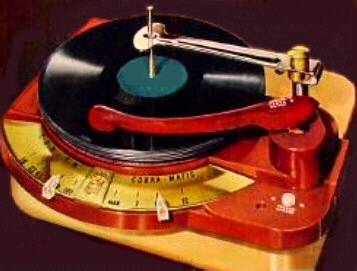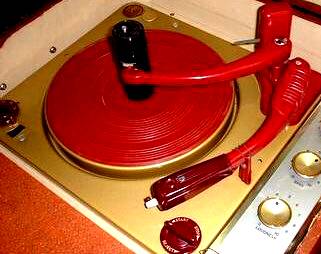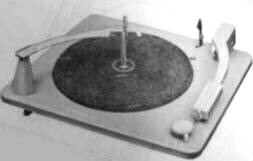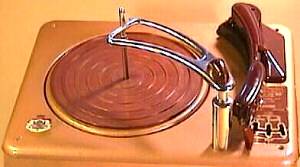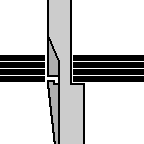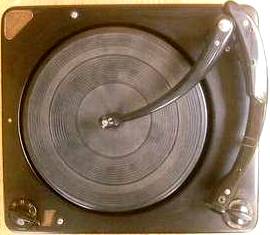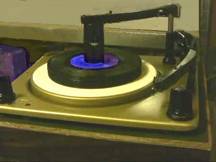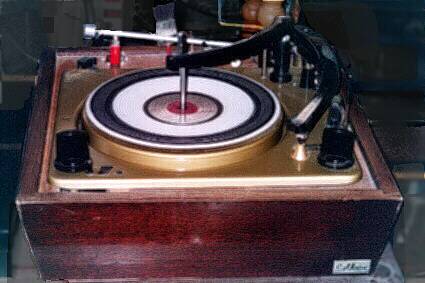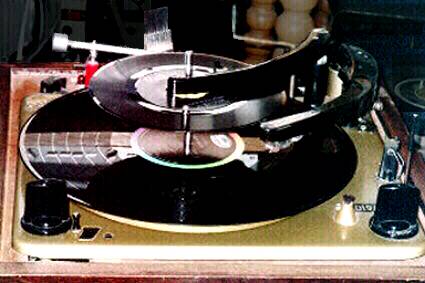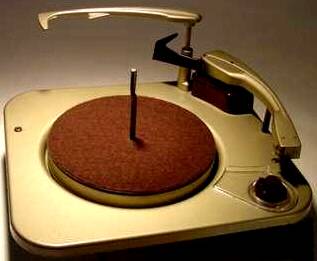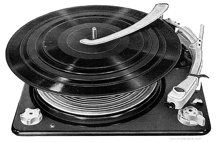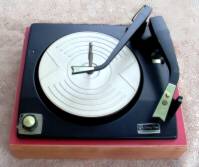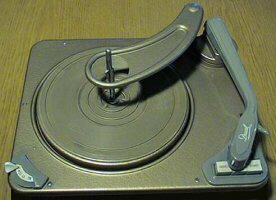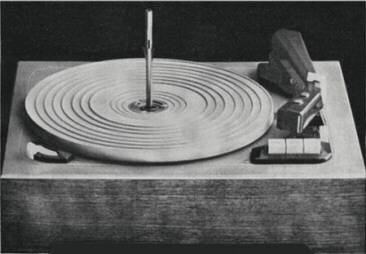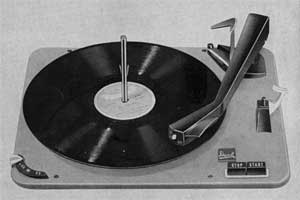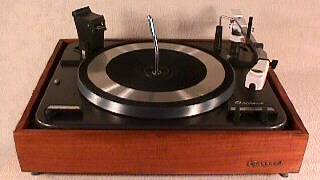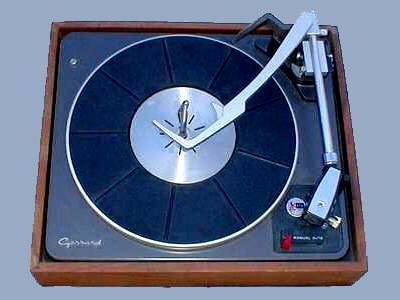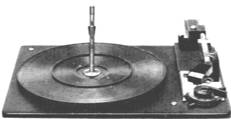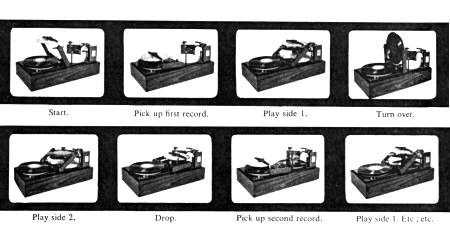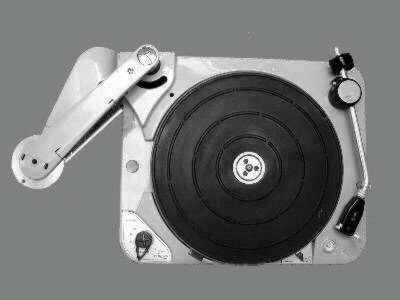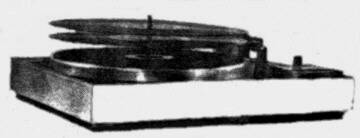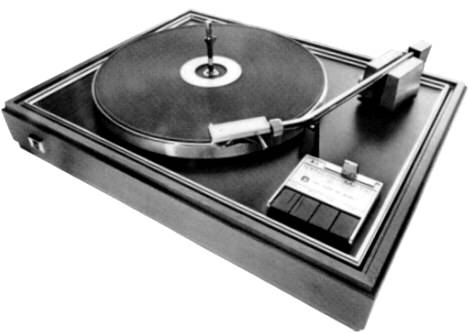The next year, 1951, stuff started getting sorted out. Engineers took to the task and came up with some remarkably sound solutions:
- Garrard (UK) produced their RC-80, a rim-push-type changer with 3
speeds and adjustable to 3 record sizes. It used the same pusher shelf Garrard
used for years, and an index arm told it when there were no records left (but
the shelf set the record size). It also had a fat slicer spindle that replaced
the standard spindle for playing 45s. They went right from single-speed to this
3-speed unit. This record changer, like their previous record changers, had no
safety drive in the mechanism that swings the arm out. If the arm is blocked
during the change cycle, damage can occur. Also, it was impossible to pick up
the arm and put it on the rest post after the changer placed it on the
record. It would not let the arm move out past the rim of the record. That's
why many early Garrards had a manual control that released control of
the arm to the user. All early Garrards also required you to remove the spindle
to remove the records from the turntable.
Within two years, Garrard had other versions of the RC-80 ready, the RC-75 budget changer, and the RC-90 audiophile changer.
- Webster (US) introduced its 100, an overarm changer with an index arm.
It could take 12", 10", and 7" records in the same stack, provided
the larger records were put on before the smaller records. Early versions required
"spider" inserts for 45s, but later versions had a large-hole slicer
spindle that fit over the standard pusher spindle (and was operated by it). Unlike
the Garrard RC-80, the Webster allowed the user to move the arm at any time.
Within two years, this overarm changer completely eclipsed all Webster changers using a side shelf, because it was so much easier to use. The side shelf changers quickly disappeared from the Webster line (and most other lines), leaving Garrard as the only major producer of record changers with side-shelf record dropping. (Garrard made them until they quit making changers.)
- Collaro (UK) introduced their 53 "Sentinel" series, a 3-speed overarm changer
with a drop sensor for telling the difference between 10" and 12" records,
and a switch for selecting either 12"-10" records, or 7" records. It
had their striking velocity trip (this is still usable today, even with very low
tracking forces).
Collaro also had a cheaper non-intermix version.
- Philips (Netherlands) also produced an overarm changer with a drop sensor for 12" records, and a switch, but the switch selected what size (7" or 10") the changer used if the drop sensor was not struck. It also had a repeat button that could prevent the next record from dropping (but it repeated any 12" record as 10" or 7" - the size selected on the switch). See it at Recordchangers.
- Thorens (Switzerland) came out with a strange overarm changer that
activated the pusher spindle from inside the overarm. It could intermix 10"
and 12" records, with a switch selecting 12"-10", or 7" operation.
One odd item was the brochure showing it loaded with all 3 sizes - a stack it
could not play automatically (see photo below).
Notice that with some of the early designs, the 7" record was just accommodated, more than it was really assimilated into the design. This is especially evident with the two record changer designs listed immediately above. Many designs required that 7" records be treated differently than the other sizes were. But the next two designs treated the 7" record as an equal to the other sizes in every way, large-hole or small-hole (but both changers did require that only one size at a time be used, because the shelf had to be set for record size in all cases).
- Philco (US) invented a unique method of dropping records with the side
shelf on its M-22. When the time to drop the record came, the shelf didn't do
anything. Instead, the entire spindle nodded toward the shelf. A step on the
shelf kept the bottom record from moving, while the latch in the spindle pushed
the other records over the top of the step. Since the bottom record didn't move,
it fell off the spindle ledge. As the record fell, the curve of the spindle
pulled it off the shelf, so it fell flat. Unfortunately, the changer repeated
the last record. The shelf rotated to 3 positions, one for each size. It
is pictured here to the lower right.
The 45 spindle for the Philco M-22 was a fat duplicate of the standard spindle that slipped over it. It nodded with the standard spindle and dropped the records just as the small spindle did - but without spiders.
A later version of this changer, the M-26, returned the arm to rest, but left the turntable rotating after the last record. It checked the position of the record clamp before the record dropped.
- Motorola came up with a weird triangular record changer, with the pickup arm and record shelf at one corner, the speed control knob at another corner, and the power-reject knob at the third corner. This changer had a rotating 45-RPM spindle. Moving the record shelf set the size. Interestingly enough, it could be set for intermediate positions and would index the arm to that size, but it would not drop records except when set at the 3 standard sizes. The first version had a position trip, and later Motorola developed a velocity trip for it. Both versions repeated the last record over and over.
One would wonder why people accepted record changers that repeated the last record over and over. Of all of the little 45 changers, only two were ever made that could shut themselves off. And many of the early 3-speed changers repeated the last record too. Some of them were even pesky enough to repeat the last record the wrong size. Did people accept them because most prewar drop changers repeated the last record, or did they not find out that the changer repeated the last record until after they already bought it?
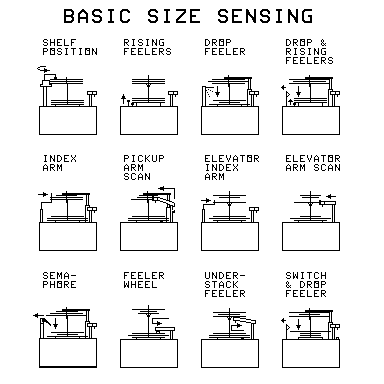
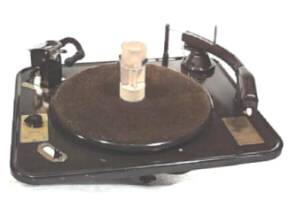
Garrard RC-80
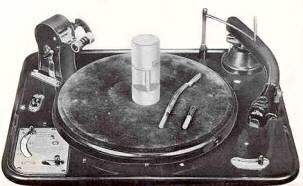
Garrard RC-90
The deluxe version of RC-80
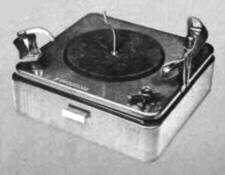
Philco M-22
Moves the whole spindle
to drop a record:
